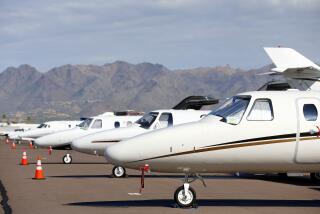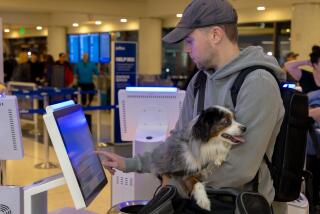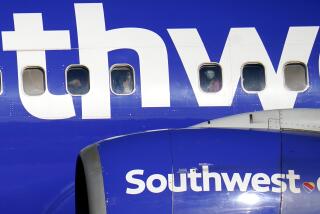Fuel costs clipping corporate jet wings
Stars really are just like us. Celebrities and other VIP types increasingly are bypassing snazzy fuel-guzzling private jets for something less glamorous, maybe even flying -- can you believe it? -- coach.
Sean “Diddy” Combs recently made a splash on the Internet when he waved his coach-class ticket for a video camera and greeted surprised fellow travelers on an American Airlines flight, complaining that lofty fuel costs had grounded his private jet. Combs’ publicists later said that the video was a spoof to dramatize high oil prices and that, since Combs was only a part owner, the jet was never actually grounded.
For the rest of us, the high cost of flying has wiped the smile off the friendly skies, propelling a wholesale lowering of expectations among travelers.
Many companies are telling employees to trade down when they fly or to travel less often. Sleek corporate jets that guzzle fuel fast enough to make Hummers look thrifty have been bumped in favor of the minivans of the sky: pokier, noisier, less-luxurious turboprop planes or piston-driven rides that might not even have a bathroom in the back.
Singer Michelle Williams isn’t ashamed to admit that she’s flying with the people these days. The former Destiny’s Child member is zipping around the country promoting a third solo album, called “Unexpected,” logging flight hours that would impress even jaded business travelers.
Williams could easily do telephone interviews with radio DJs, but hanging out on the air and in person can result in more airtime for her music. During one recent promotional week, Williams flew from Chicago to New York, then to Minneapolis, Las Vegas and San Francisco before flying back to New York and then to Chicago.
“It gets taxing, and this year it’s very costly,” Williams said. She books a coach-class ticket and uses the free miles she earns to upgrade to first class when she can. Sometimes, she just stays in coach.
“We all have to adjust. We just have to deal with it,” Williams said. “These prices are not going to come down.”
Even though oil is well off its record highs, bringing the U.S. average gas price for self-serve regular to about $3.05 a gallon, the average price of the high-octane fuels used by small aircraft is about $5.35 a gallon but can cost nearly $9 at some airports, according to AirNav.com, which provides data to help pilots plan flights.
“This has dramatically affected almost everyone who relies on aviation for their business,” said Ed Bolen, chief executive of the National Business Aviation Assn., whose 8,000 members rely on smaller general aviation airports and don’t receive the volume discounts the major airlines get on fuel.
“About 98% of our members have had to make major changes in their operations because of rising fuel costs,” Bolen said.
The squeeze is evident from takeoff and landing statistics at five airports around the nation gathered by FlightAware, a Houston-based flight tracking company.
In September, jet-engine aircraft takeoffs and landings fell 14% compared with a year earlier. Traffic by slower, more fuel-efficient turboprop planes declined by 10%. Piston-driven planes posted a 24% increase.
Some companies with their own aircraft are flying at lower speeds to conserve fuel, figuring out the most efficient routes and trying to negotiate lower fuel prices, Bolen said.
“These businesses are trying everything they can to try to save as much as possible on every flight,” he said.
FlightAware just unveiled an online service that will calculate the most efficient flight plan for customers, who can spend hours determining the optimal route, altitude and flight speed as well as where to fill up, Chief Executive Daniel Baker said.
“Fuel has never been such a large percentage of the cost of doing business, so we think it’s a good time for releasing this product,” Baker said.
Long before Ur-Energy Inc. will extract uranium ore from its Wyoming properties, the Littleton, Colo.-based mining company is digging deep for the cheapest way to fly.
Ur-Energy decided to shop around at a delicate time: The company, which also has offices in Ontario, Canada, is seeking a license to operate its first uranium mine.
Flying company executives, analysts and investors on commercial airlines became too expensive, so the 4-year-old company had to find alternatives, said Dani Wright, manager of investor and public relations.
“We can’t decide not to fly,” Wright said. “We are trying to educate people about the industry and about our company. So, we’re trying to be very selective in what we do.”
Ur-Energy hired air charter brokerage RaynAir Private Jets, another in the growing flock of operations making money by helping others fly more cheaply. Airmont, N.Y.-based RaynAir doesn’t own any aircraft but works with third-party air-charter services to book flights.
“The big corporate jet customers are dropping down to smaller and lighter jets,” said Dan Probert, who was a RaynAir account manager but recently left to start an air charter brokerage, Duke Jets. “The people who flew on the light jets are moving to turboprops, and some of the turboprop customers are moving down to piston-driven planes. Basically, everybody is trading down.”
That is good news for some companies.
September was an exceptional month for San Carlos, Calif.-based XOJets, which offers customers a choice of private jet ownership, membership and travel-on-demand plans. As of Sept. 17, the private aviation company said it had booked 80% of the business it had hoped to do that month.
XOJets’ target clientele is business travelers who fly at least 100 hours a year. Much of the new business involved trade-downs, said Adam Komack, XOJets’ chief marketing officer.
“Some of them were private jet owners who don’t want their own aircraft anymore, who are moving to membership programs where you can buy as many hours as you want. And some that no longer want to commit to a huge number of hours are switching to on-demand plans where they fly when they need to,” Komack said.
“Our customers always fly private even in a downturn economy, and I’m glad that we have the programs that will continue to allow them to do that without making a huge commitment.”
--
More to Read
Sign up for The Wild
We’ll help you find the best places to hike, bike and run, as well as the perfect silent spots for meditation and yoga.
You may occasionally receive promotional content from the Los Angeles Times.







